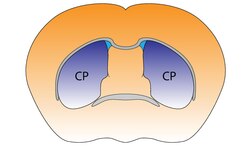Dorsal striatum
| Striatum | |
|---|---|

purple=caudate and putamen, orange=thalamus
|
|

Caudoputamen of the mouse brain
|
|
| Details | |
| Part of |
Basal ganglia Reward system |
| Components | Ventral striatum Dorsal striatum |
| Identifiers | |
| Latin | neostriatum |
| NeuroLex ID | Striatum |
| TA | A14.1.09.515 |
| FMA | 77616 |
|
Anatomical terms of neuroanatomy
[]
|
|
The striatum, also known as the neostriatum or striate nucleus, is a subcortical part of the forebrain and a critical component of the reward system. It receives glutamatergic and dopaminergic inputs from different sources and serves as the primary input to the rest of the basal ganglia system. In all primates, the dorsal striatum is divided by a white matter tract called the internal capsule into two sectors called the caudate nucleus and the putamen. The ventral striatum is composed of the nucleus accumbens and olfactory tubercle in primates. Functionally, the striatum coordinates multiple aspects of cognition, including motor and action planning, decision-making, motivation, reinforcement, and reward perception.
The corpus striatum, a macrostructure which contains the striatum, is composed of the entire striatum and the globus pallidus. The lenticular nucleus refers to the putamen together with the globus pallidus.
The striatum is in terms of its component neurons.
Adult humans continuously produce new interneurons in the striatum, and these neurons could play a possible role in new treatments for neurodegenerative disorders.
...
Wikipedia
